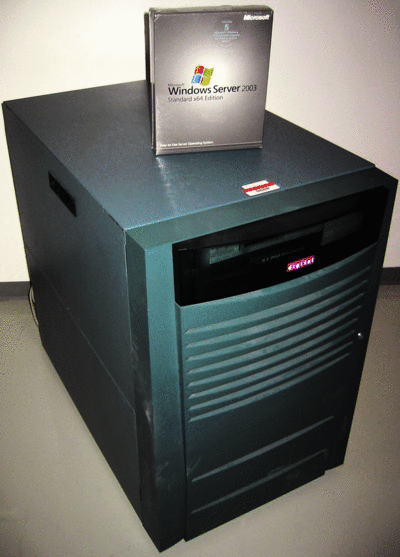Windows ConfidentialBuilding on the Past
Raymond Chen
A colleague of mine rescued an Alpha AXP machine from a dusty closet. Upon booting up the system, he discovered that it was running a 64-bit version of Windows® from early 2000. How is that possible?"
I happened to have one of these machines in my office then. In its prime, this machine was a force to be reckoned with. It was about the size of a small refrigerator and generated about as much noise as a vacuum cleaner. It contained four—count 'em, four!—Alpha AXP processors, each running at a mind-boggling 400 MHz. It had one gigabyte of RAM and thirteen gigabytes of hard drive space, striped over a dozen fast SCSI drives. This may sound puny today, but back in the 1990s, these Alpha AXP machines were the envy of the block and made you the popular kid at the lunch table.
In 1999, when Compaq announced it would no longer support Windows on the Alpha AXP, a lot of Alpha AXP systems were suddenly left sitting around Microsoft with no official duties. Some of these machines, however, were pressed into a variety of unofficial duties. I used my Alpha AXP system to index the entire Windows source code. You can imagine how convenient it can be for a programmer to be able to identify all callers of a function in just a few seconds or to locate the source code for a function or dialog box that shows up in a debug trace.
But even for the simple task of indexing the Windows source code, the Alpha AXP was soon overshadowed by x86-class machines. These were cheaper and faster, they offered more hard disk space, and they had more memory. So for this reason, my machine soon joined its forgotten brethren. It was assumed that the end of support for the Alpha AXP was the end of these machines, but then they were given an opportunity to go out in a blaze of glory, breathing their last breaths in service of the next generation.

The 64-bit Windows project was already well under way, and of the 64-bit processors under consideration, only the Alpha AXP was actually available in physical form. The Intel Itanium was still under development and ran only in a simulator, and the AMD64 architecture hadn't even been invented yet. As a result, 64-bit Windows was initially developed on the Alpha AXP.
When Compaq announced that they would no longer support Windows on the Alpha AXP, all these Alpha AXP machines that previously had been used for 32-bit Windows 2000 development and testing got repurposed and began serving a secret life as test machines for a 64-bit operating system that will never ship in that form. The Alpha AXP was merely a proof-of-concept platform.
The Alpha AXP machines served that role well, giving the 64-bit Windows team real hardware to work with instead of having to run the operating system on an Itanium simulator. (You can imagine how slow that was.) Sure, the Alpha AXP wasn't the final target hardware, but it was a big help. And when physical Itanium CPUs began showing up, the niche filled by the Alpha AXPs vanished, and they were once again retired into dusty closets.
My friends who work at the Microsoft Archives called my old, trusty Alpha AXP out of its dusty closet for this photo shoot, posing with one of the products it helped make possible: the 64-bit edition of Microsoft Windows Server® 2003. And yes indeed, that's the original dust.
Raymond Chen's Web site, The Old New Thing, and identically titled book (Addison-Wesley, 2007) deal with Windows history and Win32 programming. He would prefer not to be locked away in a dusty closet.
© 2008 Microsoft Corporation and CMP Media, LLC. All rights reserved; reproduction in part or in whole without permission is prohibited.